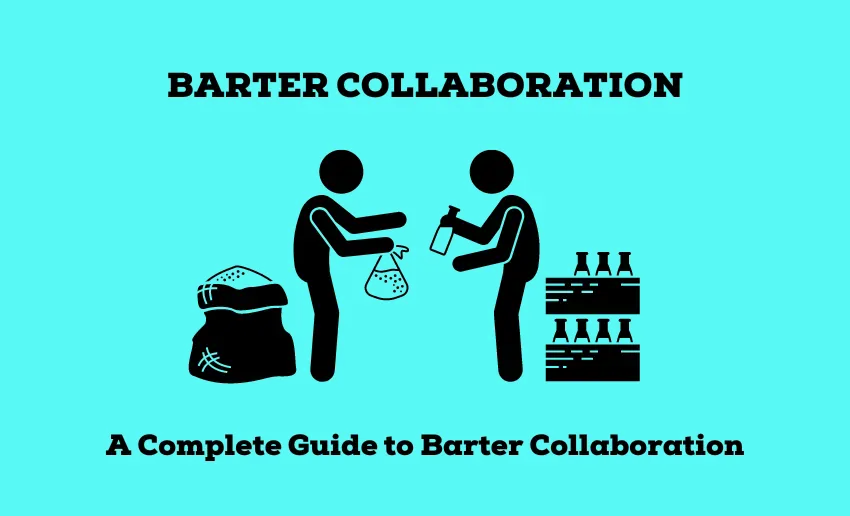In today’s ever-changing business world, old ways of trading are being reinvented. One ancient practice that’s becoming important again is barter collaboration. As we look at how business works in 2024 and beyond, it’s essential to understand what barter collaboration means now.
This guide explains barter collaboration from its roots to how it’s used today. Whether you’re an experienced businessperson wanting new strategies or someone curious about different ways of doing business, this guide will give you the information you need.
Barter collaboration meaning: what does it entail?
Barter collaboration refers to a mutually beneficial arrangement between two or more parties where goods, services, or resources are exchanged directly without the use of money. It typically involves marketers leveraging influencers to endorse their products and providing them with complimentary product samples in return. This approach is widely favored and successful in influencer marketing.
Unlike compensated collaborations, barter collaboration doesn’t involve monetary transactions throughout the process. In this type of collaboration, each party offers something of value that the other party needs or desires, creating a trade-off that benefits both sides.
Barter collaboration can occur on an individual level or within businesses, organizations, or communities, and it can involve a wide range of goods and services. The critical aspect of barter collaboration is that it promotes cooperation and resource-sharing without relying on traditional currency.
How do Barter-based collaborations work?
Barter collaborations work by allowing two separate entities to leverage each other for a specific goal. Businesses search for influencers whose followers match their target audience. If the influencer agrees, the company sends them products.
The influencer tests the products and creates content such as photos, videos, and reviews. They post this content on social media, often mentioning the brand, which benefits both the brand and the influencer.
Influencers receive products they might not purchase otherwise and make exciting content for their followers. Brands, meanwhile, reach a relevant audience without paying for regular ads.
How to work out a Barter collaboration deal
While Barter-based collaborations sound attractive, they often involve working out intricate terms of agreement that satisfy both parties. To strike a balanced barter deal, here’s what to do:
1. Identify needs
The parties involved identify what they need or what they can offer. This could be products, services, expertise, or other resources.
2. Negotiation
Once needs and offerings are identified, negotiations take place to determine the terms of the barter exchange. This includes specifying the quantity, quality, duration, and any other relevant details.
3. Exchange agreement
After negotiations, an agreement outlining the terms of the barter collaboration is reached. This agreement is often formalized through contracts or written agreements to ensure clarity and accountability.
4. Execution of exchange
The exchange takes place according to the agreed terms. For example, if it’s a product-for-service exchange, the products are delivered, and the services are rendered.
5. Monitor and evaluate
Monitor the collaboration’s progress and evaluate its effectiveness. Assess whether both parties are meeting their commitments and whether the collaboration is achieving the desired outcomes.
Is Barter collaboration suitable for all business niches?
Barter collaboration can be beneficial for many business niches, but its suitability depends on various factors. Here are some considerations:
1. Product or service type
Barter collaborations are particularly effective for businesses offering tangible products, services, expertise, or resources that can be exchanged directly. However, specific niches, such as highly specialized services or exclusive products, may find it challenging to find suitable barter partners.
2. Value proposition
Businesses must assess the value they can offer through barter collaborations and whether it aligns with their strategic goals. For some niches, barter collaborations can provide access to new markets, resources, or promotional opportunities that enhance their value proposition.
3. Market dynamics
The market dynamics of a niche can influence the feasibility of barter collaborations. Industries with high competition, complementary offerings, or shared target audiences may find barter collaborations more advantageous.
4. Relationship building
Barter collaborations can strengthen relationships with partners, customers, or stakeholders, benefiting businesses focused on building long-term connections and loyalty.
5. Flexibility and creativity
Niches that value flexibility, creativity, and innovation may thrive in barter collaborations. These collaborations encourage thinking outside the box, exploring new opportunities, and finding mutually beneficial solutions.
6. Legal and financial considerations
Businesses should consider legal, financial, and tax implications associated with barter collaborations. Specific niches may face regulatory challenges or complex valuation issues that require careful planning and compliance.
Why brands should consider Barter collaboration
1. Cost-effective marketing strategy
Barter collaborations offer brands a cost-effective marketing strategy by reducing cash expenditures. Instead of spending money on traditional advertising or influencer fees, brands can exchange products or services with influencers or other businesses. This approach helps brands reach their target audience without incurring high advertising costs, making it a budget-friendly option for marketing campaigns.
2. Access to new markets
By engaging in barter collaborations, brands can gain access to new markets and customer segments. Partnering with other businesses or influencers allows brands to tap into their partner’s existing audience and expand their reach. This can be particularly beneficial for brands looking to enter new geographic locations or target niche markets that they may not have reached through traditional marketing channels.
3. Building strong relationships
Barter collaborations help brands build strong relationships with their partners. By working closely together and exchanging value, brands and their collaborators develop mutual trust and respect. This can lead to long-term partnerships and collaborations, where both parties continue to support and promote each other’s offerings, fostering brand loyalty and customer engagement.
4. Enjoy flexibility in negotiations
One key advantage of barter collaborations is the flexibility they offer in negotiations. Brands can tailor agreements based on their specific needs and objectives, allowing for customized partnerships that align with their marketing goals. This flexibility ensures that both parties derive maximum value from the collaboration, leading to more successful outcomes.
5. Encouraging creativity and innovation
Barter collaborations encourage creativity and innovation in marketing strategies. Brands and their partners can brainstorm unique ways to promote products or services, leading to innovative campaigns that capture audience attention. This collaborative approach often results in fresh ideas and out-of-the-box solutions, helping brands stand out in competitive markets.
Why Influencers should consider Barter collaboration
1. Diversify your portfolio
Barter collaborations offer influencers an opportunity to diversify their portfolio by partnering with brands or businesses in different industries. This can expand your reach and appeal to a broader audience that aligns with your content, leading to increased engagement and follower growth.
2. Cost-effective marketing
Engaging in barter collaborations can be a cost-effective marketing strategy for influencers. Instead of requiring monetary compensation, influencers can receive valuable products or services in exchange for promoting a brand or product. This reduces expenses while still providing helpful content for your audience.
3. Build stronger relationships
Barter collaborations can help influencers build stronger relationships with brands and businesses. By working closely together on a collaborative project, you can develop a deeper understanding of each other’s values, goals, and target audiences. This can lead to long-term partnerships and future opportunities.
4. Showcase authenticity
Barter collaborations allow influencers to showcase authenticity by promoting products or services they genuinely believe in. When you’re passionate about what you’re endorsing, your audience is more likely to trust your recommendations, leading to higher conversion rates and brand loyalty.
5. Explore new opportunities
Collaborating through barter opens doors to new opportunities for influencers. You may discover unique brands, products, or services that align perfectly with your niche and audience. This exploration can lead to exciting content ideas and partnerships that elevate your influencer career.
6. Flexibility in partnerships
Barter collaborations offer flexibility in partnerships, allowing influencers to negotiate terms that suit their needs and preferences. Whether it’s the type of products or services received, the duration of collaboration, or the content creation process, influencers have more control over how they work with brands, fostering mutually beneficial relationships.
How do you negotiate terms in a barter collaboration?
Negotiating terms in a barter collaboration involves several steps to ensure a fair and mutually beneficial agreement. Here’s a simplified guide to negotiating terms effectively:
1. Define your needs and offerings
Clearly identify what you can offer and what you need in return. Understand your priorities, objectives, and boundaries before entering negotiations.
2. Research and understand the value
Research the market value of goods, services, or resources being exchanged. Understand the perceived value from both your perspective and the potential partner’s perspective.
3. Set realistic expectations
Define realistic expectations for the collaboration in terms of quantity, quality, timelines, responsibilities, and outcomes. Be transparent about what you can deliver and what you expect in return.
4. Prioritize key terms
Prioritize key terms that are non-negotiable or crucial for the collaboration’s success. Focus on aspects such as value exchange, scope of services, deliverables, and any specific requirements.
5. Propose initial terms
Initiate negotiations by proposing your initial terms and offerings. Clearly outline what you’re willing to provide and what you expect in return. Be prepared to justify your proposals with reasoning and value propositions.
6. Listen and understand
Actively listen to the other party’s proposals and concerns. Understand their needs, priorities, and limitations. Ask clarifying questions to ensure a clear understanding of their perspective.
7. Negotiate and compromise
Engage in constructive negotiations and be willing to compromise where necessary. Look for win-win solutions that balance the interests and benefits of both parties. Avoid rigid positions and be open to creative alternatives.
8. Document agreed terms
Once terms are agreed upon, document them in writing. Create a formal agreement or contract that outlines the terms, responsibilities, timelines, deliverables, and any additional conditions or clauses.
9. Review and finalize
Review the finalized terms with both parties to ensure clarity and accuracy. Address any remaining concerns or questions before finalizing the agreement.
Potential Barter collaboration challenges
Barter collaborations aren’t always as smooth as you might think. If the deal is not well structured, challenges can arise, leading to complications and undesirable outcomes.
To prevent this, it’s essential to be aware of some of the major pitfalls with Barter collaborations before embarking on it:
Valuation discrepancies
One challenge in barter collaborations is determining the fair value of goods or services exchanged. Different parties may have different perceptions of value, leading to disagreements.
Solution: To address this challenge, parties can use objective criteria for valuation, such as market prices or industry standards. Open and transparent communication about expectations and value propositions can also help align perceptions.
Limited options
Barter collaborations may have limited options available, especially if parties have specific needs or niche offerings.
Solution: To overcome this challenge, parties can explore broader networks or platforms that facilitate barter exchanges. Engaging with diverse partners and being open to alternative solutions can expand options.
Trust and reliability
Trust and reliability can be concerns in barter collaborations, as parties rely on each other to fulfill their obligations without monetary transactions.
Solution: Building trust through clear communication, past performance evaluation, and references can mitigate this challenge. Establishing clear expectations, timelines, and responsibilities in a formal agreement can also enhance reliability.
Legal and tax implications
Barter collaborations may have legal and tax implications, such as determining the taxable value of exchanged goods or services and complying with regulations.
Solution: It is crucial to seek legal and accounting advice to understand and address these implications. Including clauses in agreements that outline tax responsibilities and compliance can also mitigate risks.
Communication challenges
Effective communication is essential in barter collaborations, but misunderstandings or miscommunication can occur, leading to delays or conflicts.
Solution: Maintaining clear and frequent communication channels, such as regular updates, progress reports, and open dialogue, can prevent communication challenges. Resolving issues promptly and professionally can also strengthen collaboration.
Are Barter collaborations worth It?
Barter collaborations can be a good idea in certain situations, but they also come with considerations and potential challenges. Whether they are a good idea depends on your specific circumstances, goals, and the nature of the collaboration. It’s essential to weigh the pros and cons carefully and consider factors such as trust, transparency, and mutual benefit before engaging in barter exchanges.
7 Tips for successful Barter collaborations
1. Clearly define expectations
Clearly outline expectations, deliverables, timelines, and responsibilities from the beginning. This ensures both parties understand what is required and reduces the risk of misunderstandings or conflicts later on.
2. Communicate effectively
Maintain open and transparent communication throughout the collaboration. Regular updates, progress reports, and addressing any issues promptly contribute to a smooth and successful partnership.
3. Establish trust
Build trust with your partner by fulfilling your commitments, being reliable, and maintaining professionalism. Trust is crucial in barter collaborations as it fosters a positive relationship and promotes mutual respect.
4. Be flexible
Flexibility is critical in barter collaborations. Be open to negotiating terms, adjusting offerings, or accommodating changes as needed to ensure both parties benefit and the partnership remains productive.
5. Document agreements
Formalize agreements through written contracts or agreements. Documenting the terms, value exchange, responsibilities, and dispute resolution mechanisms provides clarity and protection for both parties.
6. Focus on value
Ensure the value exchange is fair and beneficial for both parties. Strive to provide valuable goods, services, or expertise that meet your partner’s needs while receiving value in return that aligns with your objectives.
7. Evaluate and improve
Regularly evaluate the collaboration’s progress, outcomes, and effectiveness. Use feedback and insights to identify areas for improvement, adjust strategies, and enhance future barter collaborations for tremendous success.
What is the difference between barter collaborations and paid partnerships?
Both barter collaborations and paid partnerships have their advantages and are suitable for different situations depending on the goals, resources, and preferences of the parties involved. Barter collaborations and paid partnerships differ primarily in how value is exchanged between parties:
1. Value exchange
In barter collaborations, value is exchanged directly through goods, services, or resources without monetary transactions. Each party provides something of value to the other without using money.
In paid partnerships, value is exchanged through monetary compensation. One party pays the other for their goods, services, or promotional efforts using currency.
2. Transaction type
Barter collaborations involve non-monetary transactions, where goods, services, or expertise are traded without cash changing hands.
Paid partnerships involve monetary transactions, where one party pays the other for their contributions or services.
3. Scope of exchange
Barter collaborations often involve a more flexible and diverse scope of exchange, including tangible goods, services, promotional efforts, expertise, or resources.
Paid partnerships typically focus on specific services, such as promotional campaigns, endorsements, content creation, or sponsored activities, where monetary compensation is provided in return.
4. Complexity and formality
Barter collaborations may be less formal and complex than paid partnerships, especially in smaller-scale exchanges between individuals or businesses.
Paid partnerships often require formal agreements, contracts, and financial transactions, adding a level of complexity and legal formality to the collaboration.
5. Motivation and incentives
Barter collaborations are often motivated by mutual benefit, resource-sharing, relationship-building, and strategic alliances.
Paid partnerships are driven by financial incentives. One party compensates the other for their services, expertise, or promotional activities.
In the End
Barter collaborations offer a unique and strategic partnership approach to business interactions, promoting cooperation, innovation, and mutual growth. It involves the direct exchange of goods, services, or resources without monetary transactions. However, successful barter collaborations require clear communication, mutual benefit, defined terms, trust and reliability, flexibility, evaluation and feedback, documentation, and problem-solving skills.








